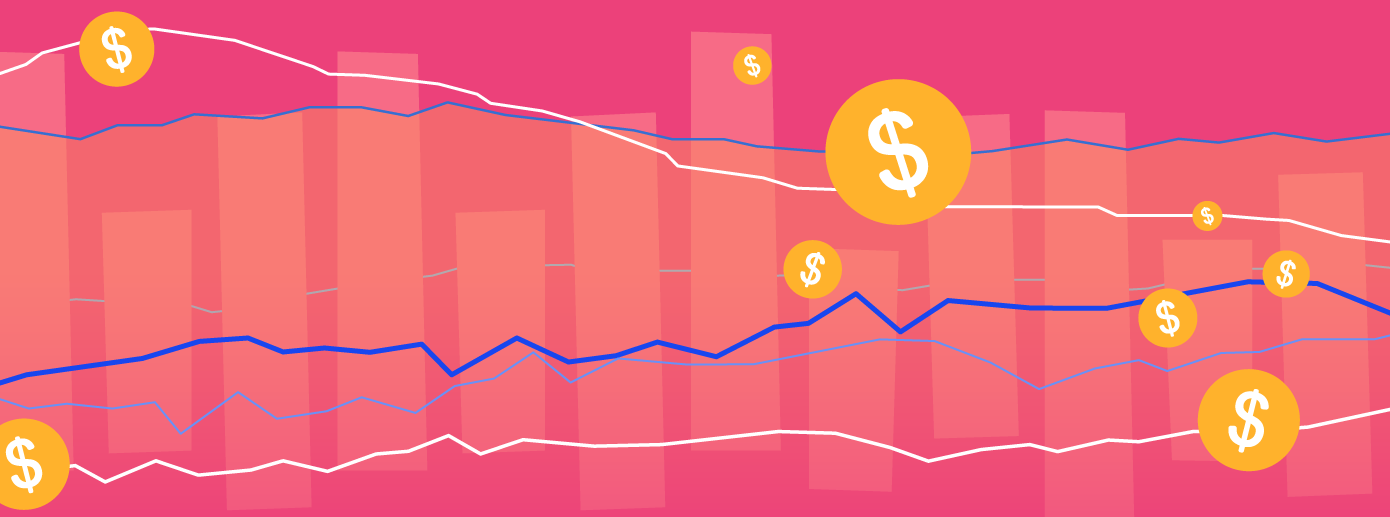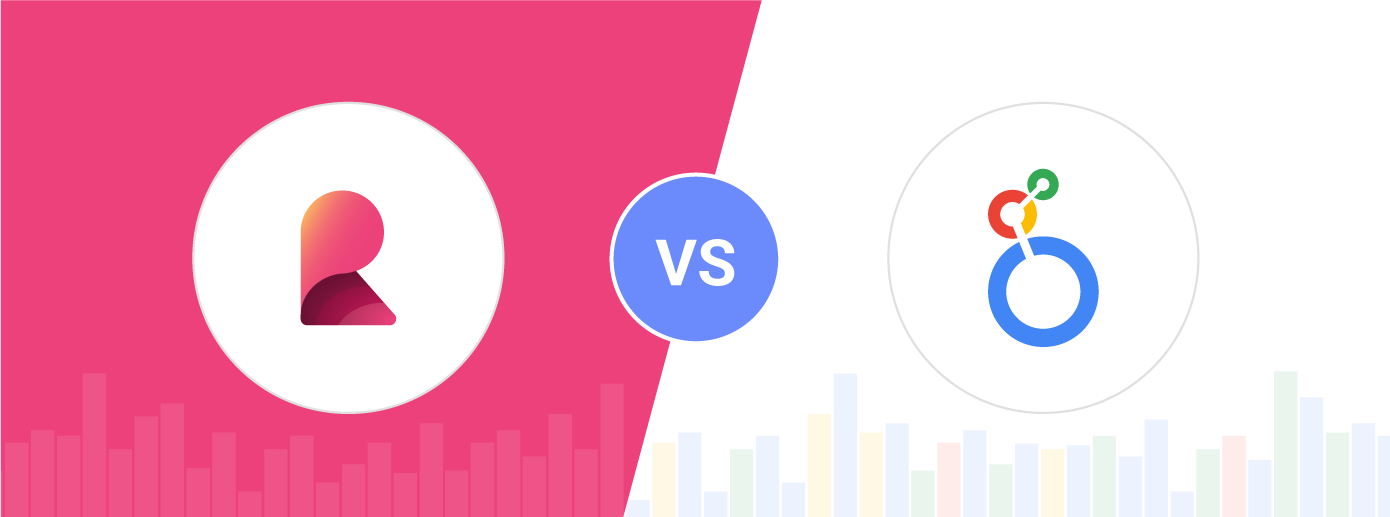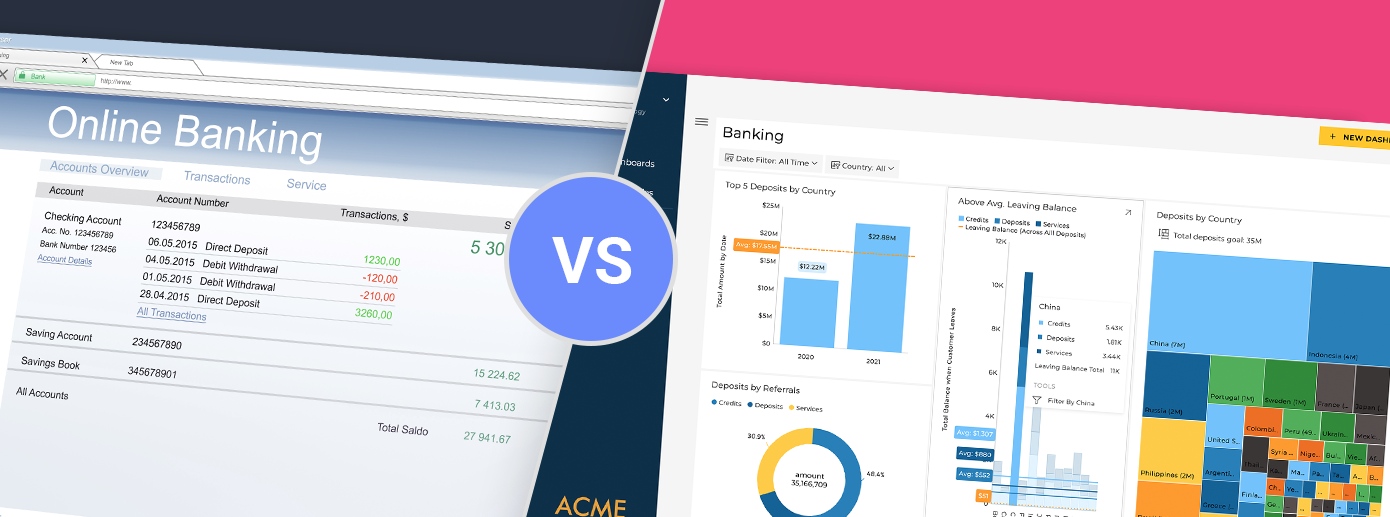
요약:
데이터 수익 창출은 더 이상 선택 사항이 아닙니다. 이는 SaaS 플랫폼과 ISV가 새로운 수익을 창출하고, 유지율을 개선하고, 혼잡한 시장에서 두각을 나타낼 수 있는 입증된 경로입니다. 그러나 대시보드를 시작하는 것은 데이터를 수익화하는 것과 같지 않습니다.
올바른 전략이 없으면 기능이 풍부한 대시보드도 견인력을 얻을 수 없습니다.
이 가이드에서는 입증된 5가지 수익 창출 모델, 단계별 출시 전략, 성장을 저해하는 일반적인 함정을 살펴보겠습니다. 로드맵을 고갈시키거나, 개발 팀을 지치게 하거나, 현금을 소각하지 않고 데이터 분석을 수익화하는 방법을 배우게 됩니다.
내장된 분석이 기반입니다. 그러나 어떻게 수익을 창출하느냐가 성공을 결정합니다. 올바른 접근 방식은 제품 전략, 사용자 행동 및 고객이 가치를 인식하는 방식에 따라 달라집니다. 아래에서는 실제 SaaS 및 ISV 기업이 핵심 제품을 손상시키지 않으면서 데이터를 수익으로 전환하는 데 사용하는 5가지 입증된 수익 창출 모델을 분석합니다.
요약
데이터 분석으로 수익을 창출하는 것은 단순히 대시보드를 추가하는 것만이 아닙니다. 인사이트를 확장 가능한 내재된 수익원으로 전환하는 것입니다. ISV 및 SaaS 플랫폼의 경우, 임베디드 분석 기능은 새로운 수익을 창출하고, 유지율을 높이고, 경쟁이 치열한 시장에서 차별화할 수 있는 가장 빠른 경로를 제공합니다. 그러나 성공 여부는 어떻게 적용하느냐에 달려 있습니다.
요점:
- 5가지 입증된 수익 창출 모델: 프리미엄(freemium), 계층형 가격 책정, 애드온, 인사이트당 지불, 화이트 라벨 분석
- 단계별 전략: 가치 있는 데이터 식별부터 올바른 모델 선택, 채택 촉진, 규정 준수 보장, 내부 팀 조정에 이르기까지
- 가장 큰 수익화 함정: 높은 개발 비용, 낮은 확장성, 커스터마이징 제한, 예측할 수 없는 가격 책정, 취약한 도입
- 임베디드 분석가 중요한 이유: 네이티브, 화이트 라벨, 확장 가능한 분석은 사용자 신뢰와 장기적인 수익을 창출합니다.
분석을 처음 시작하든, 현재 제품에서 더 많은 가치를 창출하고자 하든, 이 가이드는 결과를 빠르게 제공하는 데이터 수익화 전략을 설계하는 데 도움이 될 것입니다.
임베디드 분석 수익으로 전환하는 5가지 데이터 수익 창출 모델
분석으로 성공적으로 수익을 창출하려면 대시보드 이상의 것이 필요합니다. 그 뒤에는 비즈니스 모델이 필요합니다. 올바른 접근 방식은 고객이 제품을 지불하고, 사용하고, 성장하기를 원하는 방식에 부합합니다.
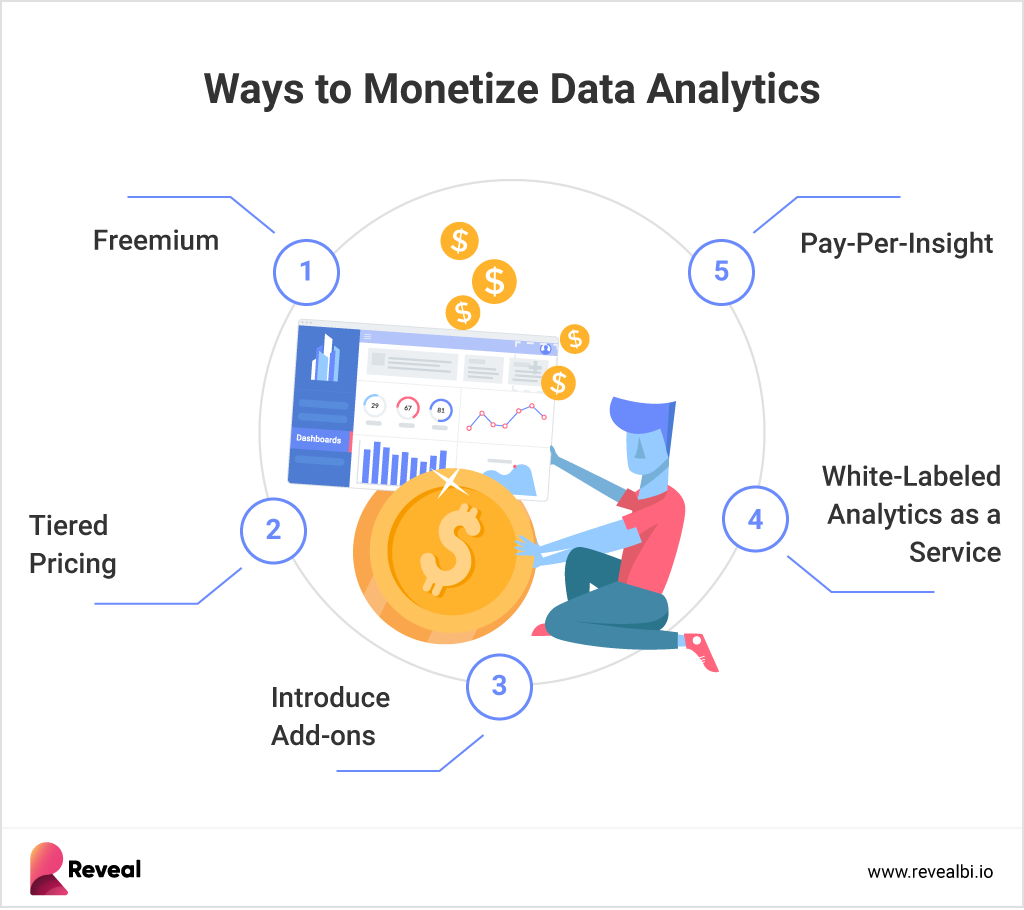
그래서 ISV 및 SaaS 기업이 분석을 효과적으로 수익화할 수 있는 5가지 입증된 방법을 모았습니다.
프리미엄(Freemium)
사용자에게 분석을 맛보고 실제 가치에 대해 비용을 청구하십시오. 프리미엄(Freemium) 모델을 사용하면 약정을 요청하기 전에 ROI를 입증할 수 있으며, 영업 압박 없이 참여를 수익으로 전환할 수 있습니다. 직접 액세스하면 신뢰가 구축되고 데모나 온보딩 장애물 없이 업그레이드가 가능합니다.
다음과 같은 기능을 게이트할 수 있습니다.
- 셀프 서비스 대시보드 생성
- AI 예측 분석 및 추세 예측
- 고급 필터링 및 드릴다운
- 공유 기능의 데이터 내보내기
작동하는 이유:
- 가치 창출 시간 단축 - 사용자가 지불하기 전에 ROI를 경험할 수 있습니다.
- 사용량이 증가함에 따라 자연스러운 업그레이드 트리거를 생성합니다.
- 고압적인 판매 없이 사용량을 수익으로 전환
적합한 대상:
SaaS 플랫폼은 사용자 확보를 늘리는 동시에 시간이 지남에 따라 상향 판매 기회를 구축하고자 합니다.
계층형 가격 책정
계층화된 가격 책정을 통해 고객 세그먼트 전반에 걸쳐 데이터 수익 창출 전략을 확장하여 고급 분석 기능을 기존 제품 계획에 맞게 조정할 수 있습니다. 패키징을 과도하게 복잡하게 만들지 않고 데이터 분석을 수익화할 수 있는 유연한 방법입니다.
엔트리 레벨 플랜에서 정적 대시보드로 시작하여 고객이 더 높은 플랜으로 진행함에 따라 사용자 지정 대시보드, AI 기반 예측 및 API 액세스와 같은 고부가가치 기능을 잠금 해제하세요.
다음과 같은 줄에 따라 액세스를 분할할 수 있습니다.
- 스타터: 보기 전용, 사전 구축된 대시보드
- 장점: 편집 가능한 대시보드, 고급 필터, 경고
- 엔터프라이즈: 완전한 화이트 라벨 제어, API 통합, 예측 분석
작동하는 이유:
- 실제 기능을 실제 가치에 연결하여 사용자당 평균 수익(ARPU)을 높입니다.
- 분석 깊이를 고객 성숙도에 매핑하여 업그레이드 추진
- 인원수뿐만 아니라 사용량에 따라 가격을 조정합니다.
적합한 대상:
ISV 및 SaaS 플랫폼은 명확한 제품 계층과 다양한 데이터 성숙도 수준의 다양한 고객 기반을 갖추고 있어 최신 소프트웨어를 위한 가장 효과적인 데이터 수익 창출 전략 중 하나입니다.
애드온 소개
애드온은 핵심 가격 책정 모델을 중단하지 않고 분석으로 수익을 창출할 수 있는 간단하고 확장 가능한 방법입니다. 전반적으로 가격을 인상하는 대신 기본 제품을 간결하게 유지할 수 있습니다. 고객은 실제로 사용하는 고급 데이터 기능에 대해서만 비용을 지불합니다.
다음과 같이 분석을 제공할 수 있습니다.
- $X/month를 위한 인사이트 번들
- 규정 준수 보고 모듈
- 화이트 라벨 대시보드 툴킷
- 데이터 내보내기 도구 집합
작동하는 이유:
- 기본 가격에 영향을 주지 않고 유연하고 마진이 높은 수익을 추가합니다.
- 비분석 사용자를 위해 엔트리 레벨 가격을 낮게 유지합니다.
- 시간이 지남에 따라 데이터 수익 창출 전략을 테스트하고 개선할 수 있습니다.
적합한 대상:
모듈식 가격 책정 모델을 사용하는 SaaS 공급업체 또는 보고가 필요하지만 전체 분석에 대한 선불 비용을 지불하고 싶지 않은 규제 산업의 고객.
인사이트당 지불
Pay-per-insight는 구독이나 기능 게이팅 없이 분석을 수익원으로 전환합니다. 고객은 보고서, 내보내기 또는 예측이 필요한 경우에만 비용을 지불합니다. 이는 서비스형 분석(Analytics as a Service)이지, 고정된 계획이 아닙니다. 가격을 부풀리거나 사용하지 않는 기능을 유료 요금제에 강제로 넣지 않고 분석으로 수익을 창출할 수 있는 방법입니다.
온디맨드 분석이라고 생각하면 사용자는 필요할 때 가치를 얻을 수 있고 기업은 필요할 때마다 돈을 받습니다.
다음과 같은 항목에 대해 요금을 청구할 수 있습니다.
- 전체 보고서 내보내기(PDF, Excel)
- 원클릭 추세 예측
- 임계값 기반 데이터 액세스(예: 100행 이후)
- On-demand simulations 및 what-if 모델
작동하는 이유:
- 거래 수익 창출
- 계획 변경 없이 가치 제공
- 빈도가 낮고 가치가 높은 사용 사례에 적합
적합한 대상:
의료, 금융 또는 물류 분야의 SaaS 공급업체에 적합하며, 온디맨드 보고는 사용자를 전체 계획에 얽매이지 않고도 유연한 데이터 수익 창출 전략을 지원합니다.
화이트 라벨 Analytics as a Service
고객이 귀하의 분석을 자신의 것으로 브랜드화할 수 있도록 하십시오. 화이트 라벨링을 사용하면 엔진을 제공하고 엔진을 제어하여 비주얼을 제어합니다. 그것은 그들의 로고, 그들의 색상, 그들의 도메인이지만 당신의 인프라입니다.
다음과 같은 비용을 청구할 수 있습니다.
- 테넌트당 화이트 레이블 활성화
- 사용자 정의 브랜딩 옵션(로고, 테마, 색상)
- 브랜드 내보내기(PDF, PPT, Excel)
- 고객의 도메인에 분석 포함
작동하는 이유:
- 최소한의 노력으로 인지된 가치를 높입니다.
- 고객이 자신의 통찰력을 보여줄 수 있도록 지원
- 기업 또는 리셀러 사용을 위한 프리미엄 가격 책정을 정당화합니다.
적합한 대상:
브랜드 제어가 필수적인 기업 및 에이전시 환경으로, 화이트 라벨링은 데이터 분석을 수익화하는 가장 효과적인 방법 중 하나입니다.
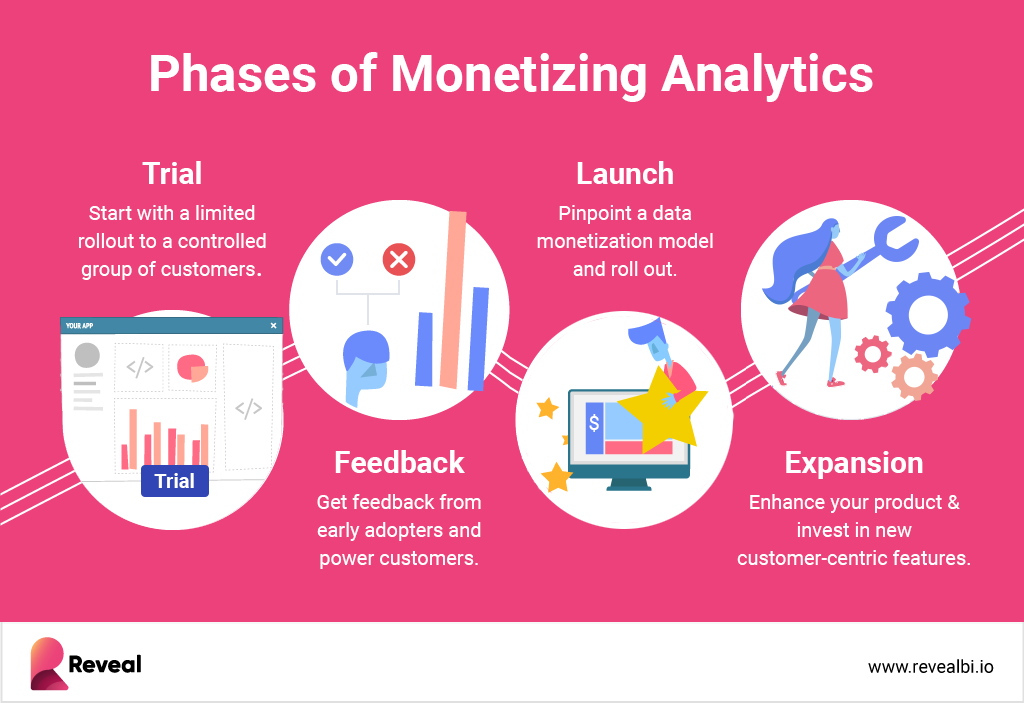
데이터 수익화 전략 구축
제품에 분석 기능을 도입하는 것만으로는 수익을 창출하기에 충분하지 않습니다. 왜? 사용자는 적절한 데이터 수익 창출 계획을 구현하더라도 가치 있게 여기지 않거나 사용하지 않는 기능에 대해 비용을 지불하지 않습니다. 진정한 데이터 수익화 전략은 "사용자가 계속해서 비용을 지불할 만큼 가치 있는 것은 무엇인가?"라는 한 가지 질문에서 시작됩니다. 대답할 수 없다면 어떤 가격 책정 모델도 당신을 구할 수 없습니다.
확장 가능한 제품 중심의 데이터 수익화 전략을 수립하는 데 필요한 사항을 분석해 보겠습니다.
1단계: 수익 잠재력이 있는 인사이트 파악
모든 데이터로 수익을 창출할 수 있는 것은 아닙니다. 고객은 단순한 수치가 아닌 실제 문제를 해결하는 통찰력을 얻기 위해 비용을 지불합니다.
예를 들어, 예측 배송 인사이트를 실시간 추적 데이터와 결합하면 물류 및 소매업체가 배송 지연을 줄이는 데 도움이 될 수 있습니다. 이러한 종류의 통찰력은 정보를 제공할 뿐만 아니라 비용을 절감하고 행동을 유도합니다. 이것이 바로 고객이 지불할 가치입니다.

이를 염두에 두고 코드가 적거나 코드가 없는 개발 도구를 제공하는 분석 솔루션에 투자해야 데이터 분석 제품을 수익화할 수 있는 기회를 얻을 수 있습니다.
권장 조치:
- 데이터 인벤토리: 플랫폼 전반에서 수집, 생성 및 추적하는 데이터를 감사하세요.
- 문제 정렬: 고객이 해결해야 하는 주요 과제에 데이터를 매핑합니다.
- 인사이트 우선순위 지정: 명확한 비즈니스 가치와 함께 영향력이 크고 수요가 많은 인사이트에 집중합니다.
2단계: 제품에 적합한 수익 창출 모델 매칭
잘못된 데이터 수익 창출 모델을 선택하면 채택이 지연되거나, 사용자에게 혼란을 주거나, 의미 있는 수익 기회를 놓치게 됩니다. 올바른 모델은 고객이 플랫폼을 사용하는 방식과 인사이트를 얻기 위해 비용을 지불할 의향이 있는 방식과 일치합니다.
예를 들어, 의료 관련 제품을 전문으로 하는 SaaS 회사는 고객이 주기적으로만 보고서를 필요로 하기 때문에 인사이트당 지불 모델을 활용할 수 있습니다. 따라서 구독료보다 보고서당 지불하는 것이 훨씬 더 편리합니다. 또한 이 방법은 병원 청구 관행에 더 부합할 것입니다.

권장 조치:
- 행동 기반 가격 책정: 기능 가용성뿐만 아니라 사용자가 제품과 상호 작용하는 방식에 맞게 가격 책정 모델을 조정합니다.
- 제어된 롤아웃: 확장하기 전에 대상 사용자 세그먼트를 대상으로 새 모델을 테스트합니다.
- A/B 테스트: 변형 전반에 걸친 채택 및 수익 영향을 측정합니다.
- 데이터 기반 조정: 사용자 피드백 및 전환 데이터를 기반으로 접근 방식을 구체화합니다.
3단계: 최종 사용자를 위한 디자인
고급 분석 기능조차도 고정되어 있다고 느끼면 실패합니다. 사용자는 임베디드 분석 기능이 제품의 모양과 느낌과 일치하고 제품에 속한 것처럼 작동하기를 기대합니다. 분석은 직관적이고 빠르며 앱의 UX에 완전히 통합되어야 합니다. 포함된 화이트 라벨 분석은 더 나은 보안을 제공하고 채택을 증가시킵니다.
핀테크 사용자는 포트폴리오 데이터가 포함된 팝업 분석 위젯을 신뢰하지 않을 것입니다. 그러나 임베디드 분석 솔루션이 앱의 일부처럼 느껴지면 다른 보안 기능처럼 취급합니다.
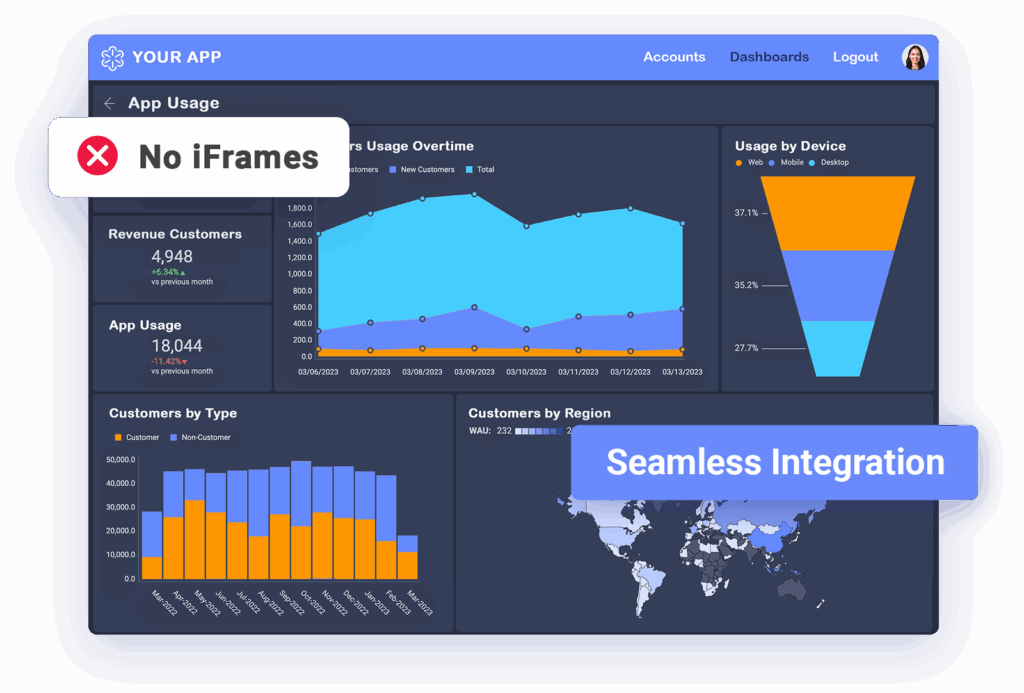
권장 조치:
- 네이티브 통합: iFrame을 사용하지 않고 앱에 직접 분석을 포함할 수 있습니다.
- 브랜드 대시보드: 테마, 레이아웃 및 시각적 개체를 제품의 UI에 맞춥니다.
- 셀프 서비스 도구: 최종 사용자를 위해 드래그 앤 드롭 대시보드 생성을 활성화합니다.
4단계: 규정 준수를 경쟁 우위로 전환
분석이 아무리 강력하더라도 부실한 거버넌스는 신뢰를 떨어뜨리고 규정 준수를 무너뜨리며 기업 거래를 잃게 됩니다. 고객을 잃기 위해 연방 명령을 위반할 필요는 없습니다. 내부 보안 표준을 놓치면 주저 없이 당신을 떨어뜨릴 것입니다.
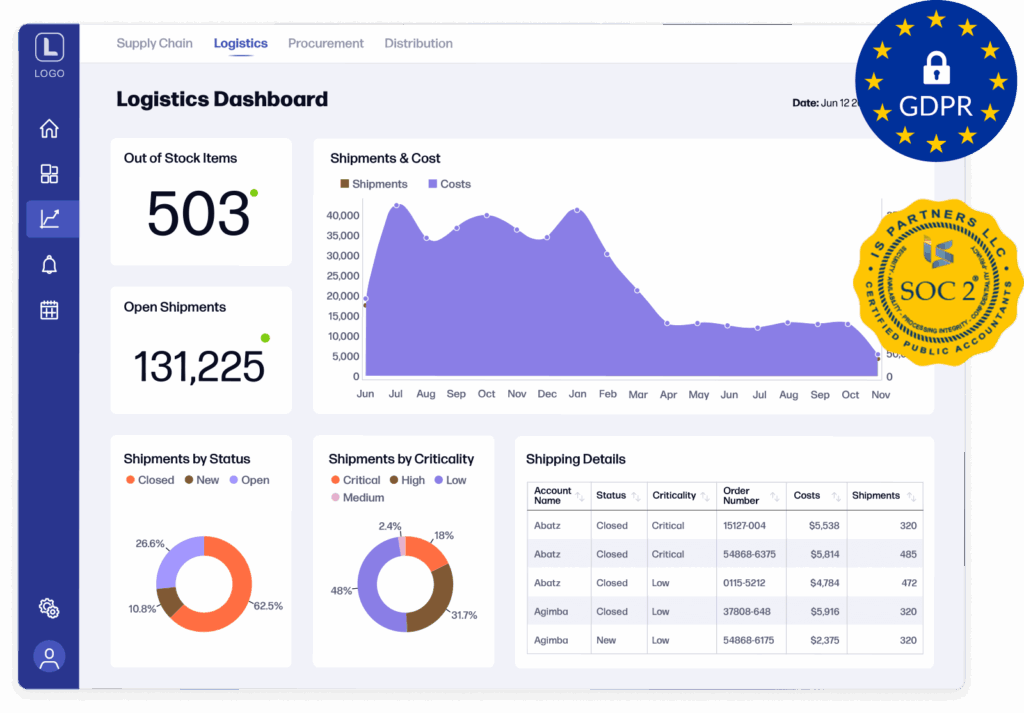
권장 조치:
- 보안 아키텍처: 엄격한 역할 기반 액세스 제어를 통해 다중 테넌트 인프라를 구현합니다.
- 규정 준수: 분석 환경 내에서 GDPR, CCPA 및 HIPAA 표준을 충족합니다.
- Built-In Governance: 내장 거버넌스: 기본 데이터 거버넌스 기능이 있는 솔루션을 사용하여 보안 및 규정 준수를 간소화합니다.
5단계: 성과가 수익 창출을 망치지 않도록 하기
느리고 신뢰할 수 없는 대시보드는 채택을 죽이고 결과적으로 수익을 떨어뜨립니다. 대시보드는 아름다울 수 있지만 실제 사용에서 지연되면 사용되지 않습니다. 확장은 단순히 신규 사용자를 추가하는 것이 아닙니다. 이는 전체 사용자 기반에서 데이터 볼륨, 쿼리 및 사용 사례가 증가함에 따라 성능을 강력하게 유지하는 것입니다.
확장 가능한 유연한 임베디드 분석 솔루션을 사용하면 기존 사용자와 신규 사용자 모두의 증가하는 요구 사항을 충족할 수 있습니다. 따라서 수익을 확대할 수 있습니다.
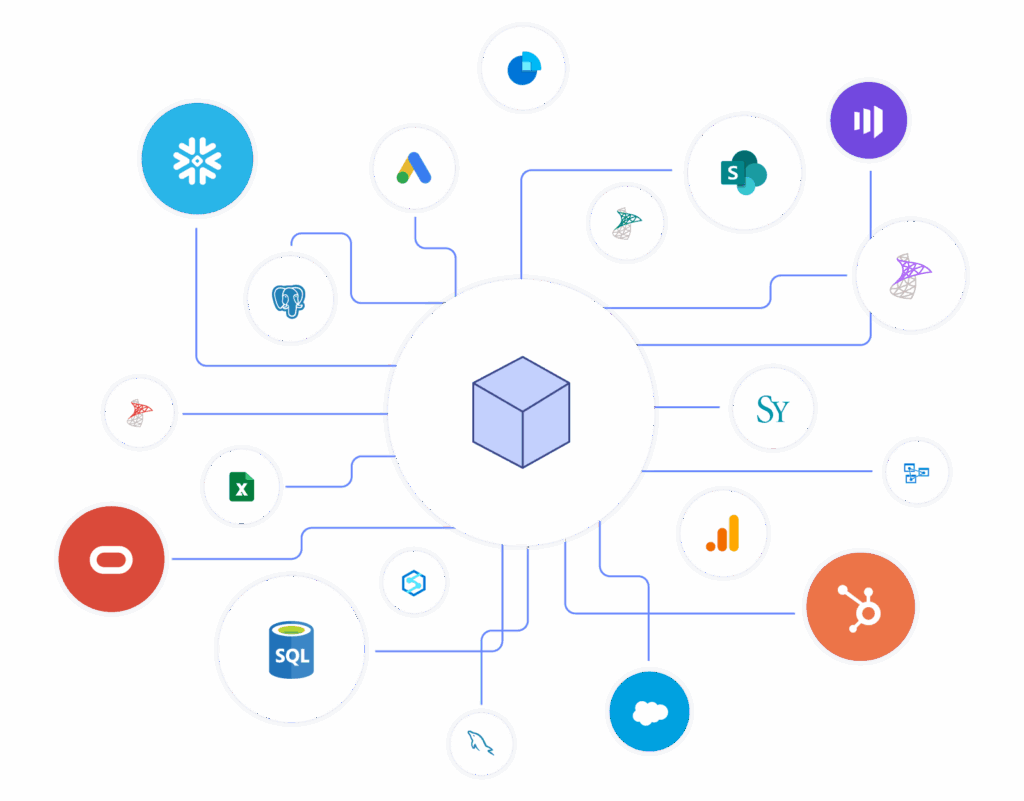
권장 조치:
- 확장 가능한 아키텍처: 인 메모리 및 쿼리 기반 확장을 모두 지원하는 플랫폼을 선택합니다.
- 실제 테스트: 데모 시나리오뿐만 아니라 실제 사용 조건에서 성능을 평가합니다.
- 예측 가능한 비용: 사용량이나 성장에 관계없이 고정 가격을 제공하는 공급자와 협력합니다.
- 지속적인 성능: 사용자 기반이 확장됨에 따라 대시보드의 속도와 응답성을 유지하도록 설계된 아키텍처를 사용합니다.
6단계: 내부 정렬
분석으로 수익을 창출할 수 있으려면 내부 팀이 이를 홍보하고 판매할 수 있어야 합니다. 따라서 광고 대상, 기능, 고객 고충 사항 및 분석을 통해 문제를 해결하는 방법에 대한 내부 조정이 필요합니다.

권장 조치:
- 팀 트레이닝: 고객 대면 팀에게 분석 오퍼링의 가치와 기능에 대해 교육합니다.
- 영업 지원: 데모 스크립트, FAQ 및 사용 사례 가이드와 같은 리소스를 팀에 제공하세요.
- 단순성 설계: 직관적인 UI와 데모하기 쉬운 대시보드를 활용하여 조정 및 교육을 지원합니다.
마지막 팁: 간단하게 시작
복잡한 수익 창출 계획은 사용자를 혼란스럽게 하고 채택을 지연시킬 뿐입니다. 단순성을 통해 검증 속도가 빨라지고 수익 창출이 빨라집니다.
예를 들어, SaaS 플랫폼이 무엇이 무료이고 무엇이 지불되는지 명확하게 알려주는 프리미엄(freemium) 분석 솔루션을 출시하면 사용량, 숨겨진 비용 및 컴퓨팅 성능을 기반으로 복잡한 지불 체계를 만드는 것보다 훨씬 더 많은 수익을 창출할 수 있습니다.
고객은 계획하고 예산을 책정할 수 있는 명확한 가격 책정을 원하며, 혼란은 수익 손실로 이어질 뿐입니다.
권장 조치:
- 명확한 출시 전략: 측정 가능한 결과와 연결된 단일 수익 창출 모델로 시작하세요.
- 채택 우선: 사용자 채택의 우선 순위를 지정하여 제품 시장 적합성 및 가격을 검증합니다.
- 증거를 통한 확장: 실제 사용과 결과를 통해 성공을 확인한 후에만 확장할 수 있습니다.
애널리틱스 수익 창출의 문제점
분석으로 수익을 창출하는 것은 처음에는 간단해 보이지만, 대부분의 SaaS 및 ISV는 리소스를 고갈시키고 성장을 늦추며 ROI를 저해하는 숨겨진 위험에 직면해 있습니다. 올바른 접근 방식이 없으면 분석 프로젝트는 수익성 있는 기능 대신 값비싼 부채로 변하게 됩니다.
ISV 및 SaaS 기업이 분석을 수익화할 때 직면하는 가장 큰 5가지 과제를 살펴보겠습니다.
높은 개발 비용
사내에서 분석을 구축하면 거의 항상 비용이 많이 들고 예상보다 시간이 오래 걸립니다. 종종 단순한 대시보드 기능으로 시작된 것이 수개월의 추가 개발, 예산 초과 및 과도한 유지 관리 요구로 바뀝니다. 이로 인해 핵심 제품에서 귀중한 리소스가 빠져나가고, 기능 출시가 지연되며, 경쟁 속도가 저하됩니다.
완화 방법:
- 빌드, 유지 관리 및 지원 단계에서 총 비용을 신중하게 예측합니다.
- 분석이 주요 제품 초점이 아닌 한 임베디드 분석 솔루션 구매의 우선 순위를 정하십시오.
- 내부 빌드 경로를 선택하는 경우 진행 중인 업데이트에 전용 리소스를 할당합니다.
확장성 문제
소규모 데이터 세트를 위해 구축된 분석 솔루션은 실제 부하로 인해 무너지는 경우가 많습니다. 사용자가 증가하고 데이터 볼륨이 확장됨에 따라 느린 대시보드, 지연된 쿼리 및 일관되지 않은 성능으로 인해 신뢰와 사용량이 빠르게 저하됩니다. 분석 속도가 느려지면 사용자가 이탈하고 지원 대기열이 급증합니다.
완화 방법:
- 확장을 위해 구축된 임베디드 분석 솔루션 찾기
- 전체 롤아웃 전에 실제 데이터 크기와 사용자 동시성을 사용하여 분석 플랫폼을 스트레스 테스트합니다.
- 인메모리 기능 또는 확장을 위한 분산 데이터 처리를 통해 아키텍처를 설계합니다.
- 로드 시간과 사용량 메트릭을 지속적으로 모니터링하여 조기 경고 신호를 파악합니다.
사용자 정의 부족
애플리케이션의 모양과 느낌과 일치하지 않는 분석은 사용자 경험을 손상시킵니다. 일관성 없는 대시보드는 사용자 신뢰를 무너뜨리고 업그레이드 가능성을 떨어뜨립니다. 제품의 일부처럼 느껴지지 않으면 사용자는 사용할 가치가 있는 것으로 않을 것입니다.
완화 방법:
- 테마, 로고, 글꼴 및 UI 정렬을 포함한 완전한 화이트 라벨링 기능을 보장합니다.
- 분석 기능을 앱에 기본적으로 내장하여 iFrame 기반 바로가기를 사용하지 않습니다.
- 최종 사용자가 특정 요구 사항에 맞게 대시보드를 개인화할 수 있습니다.
예측할 수 없는 가격 책정 모델
많은 임베디드 분석 플랫폼은 사용자, 세션 또는 API 호출에 따라 요금을 청구합니다. 채택이 증가함에 따라 비용도 증가하며, 이로 인해 예산 책정의 악몽, 마진 잠식, 예측할 수 없는 수익성이 발생합니다. 이는 수익 창출 전략 전체를 훼손합니다. 성공적인 확장은 자신의 성공으로 인해 운영 비용이 부풀려질 때 더 어려워집니다.
완화 방법:
- 간단한 고정 가격 모델을 갖춘 임베디드 분석 솔루션을 선택하십시오.
- 향후 사용자 성장 시나리오를 예측하여 장기적인 플랫폼 비용을 평가합니다.
- 수익 창출 전략을 사용 수수료 상승으로 제한되지 않는 수익원에 맞게 조정하세요.
사용자 채택 주저
분석이 기술적으로 강력하더라도 사용자는 투박하거나 느리거나 앱과 연결이 끊긴다고 느끼면 이를 채택하지 않습니다. 낮은 UX는 이탈을 유발하고 수익 창출 분석 기능의 수익 잠재력을 약화시킵니다. 강력한 채택이 없으면 상향 판매 분석이 거의 불가능해집니다.
완화 방법:
- 분석을 앱의 핵심 환경에 직접 임베드하여 iFrame 또는 외부 리디렉션을 피합니다.
- 분석 UX/UI를 제품의 나머지 부분과 정확히 일치시킵니다.
- 빠른 로딩 시간, 깔끔한 탐색, 직관적인 셀프 서비스 기능을 우선시합니다.
Reveal로 애널리틱스로 수익 창출 시작
분석으로 수익을 창출하는 것은 기능이 아닙니다. 처음부터 제품, 가격 책정 및 사용자 경험에 통찰력이 구축될 때만 작동하는 비즈니스 모델입니다. 연결되지 않은 대시보드와 틀에 짜인 추가 기능은 전략이 아니며 마찰을 일으키고 채택, 참여 및 성장을 약화시킵니다.
Reveal는 데이터를 핵심 제품의 일부로 만들어 원활하고 브랜드에 적합하며 확장 가능한 방식으로 구축함으로써 이 문제를 해결합니다.
내장된 분석 기능을 사용하면 다음을 수행할 수 있습니다.
- 더 빠른 배송: 12개월의 빌드 주기를 건너뛰고 분기가 아닌 몇 주 만에 출시할 수 있습니다.
- 채택 유도: 앱의 자연스러운 확장처럼 느껴지는 네이티브 환경을 제공하세요.
- 예상치 못한 규모 없이 확장: 귀사에 불리한 것이 아니라 귀사와 함께 성장하는 고정 가격을 제공하는 임베디드 분석 제공업체를 선택하십시오.
- 원하는 방식으로 수익 창출: 핵심 앱을 변경하지 않고도 고객의 실제 요구 사항에 맞는 프리미엄(freemium) 업그레이드, 계층형 분석 계획 또는 인사이트당 지불 모델을 만들 수 있습니다.
Reveal는 분석을 기능 그 이상으로 바꿔줍니다. 그것은 당신의 제품 내에서 고유한 브랜드 수익원이 됩니다.
관련 기사


 블로그로 돌아가기
블로그로 돌아가기